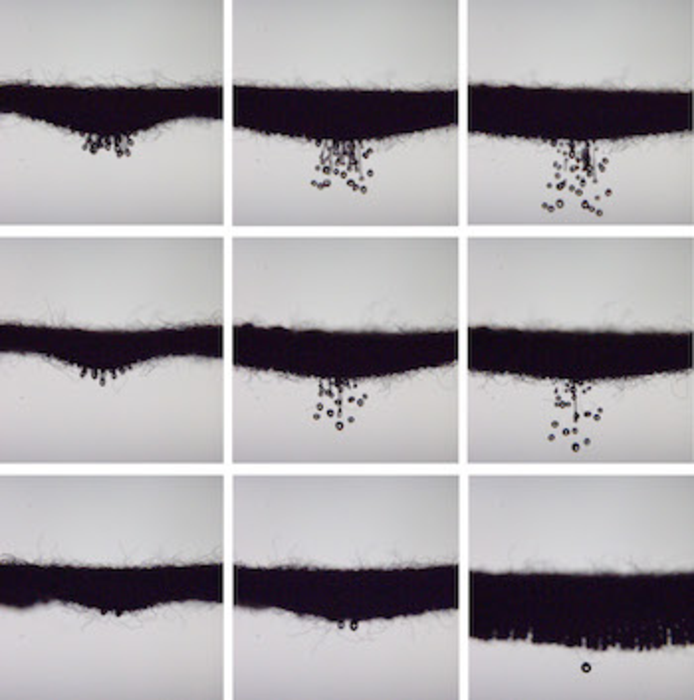Building better air filters could help head off the next pandemic. At the 74th Annual Meeting of the APS Division of Fluid Dynamics, scientists will present the latest results on how future face masks may work, what happens when masks get wet, and why improper mask usage can sometimes be worse than no mask at all.

Credit: Credit: S. Bagchi and A. Saha (UCSD)
Building better air filters could help head off the next pandemic. At the 74th Annual Meeting of the APS Division of Fluid Dynamics, scientists will present the latest results on how future face masks may work, what happens when masks get wet, and why improper mask usage can sometimes be worse than no mask at all.
They will announce the findings and take questions from journalists at a live virtual press briefing on Tuesday, November 23, 2021, from 12:00 p.m. to 1:00 p.m. U.S. Mountain Standard Time (MST).
Before the masks of the future are ready to wear, scientists from the University of California San Diego, Indian Institute of Science, and University of Toronto have honed in on what makes our current face masks functional or risky.
Abhishek Saha, a UCSD professor of engineering, wanted to tackle a simple yet commonplace problem: damp mask.
“What happens to the efficacy of a mask when we wear it for a long time? Indeed, the mask gets progressively wet due to condensation from our breathing. Will that affect the performance?” he said.
Saha will present new findings from an experiment that tests two different types of mask getting progressively wetter. He will share whether gradual wetting deteriorates how well the mask can catch respiratory droplets. Additionally, he will discuss how wearing a mask for a long time can affect how it fits on your face, potentially causing side leakage.
The results on wet masks are forthcoming shortly from Physical Review Fluids.
In a recent paper, the researchers reported on dry masks as well. “Large respiratory droplets generally settle on the ground quickly due to gravity, so they are assumed to be less harmful. But for a dry mask, we found that a large respiratory droplet can penetrate the mask matrix and produce many small droplets with enhanced airborne lifetime,” Saha said. “Improper masking can cause these large droplets to atomize.”
Meanwhile, other scientists have turned to designing a different kind of filtration system.
“We are using tortuous animal nasal cavities as an inspiration to design new filter channels that can screen particles from air and operate under relatively low pressure gradients, which is a measure of the energy expenditure,” said South Dakota State University mechanical engineering student Majed Jafar Diab, who will present the research.
Using CT scans, the scientists peeked inside the noses of pigs, dogs, possums, guinea pigs, and rabbits, as well as Australian marsupials: a tiny cat called the northern quoll, the eucalyptus-loving greater glider, and the potoroo, a ratlike creature related to the kangaroo.
The researchers then designed and 3D-printed the filters—which require less effort to draw in air than today’s masks—and tested them in a wind tunnel.
“Beyond application in mask covers, the bioinspired concept for filters can also be used to design large-scale baffles for industrial applications and, in general, to promote air sanitation in confined, crowded spaces,” said Saikat Basu, a professor at South Dakota State University who worked with Diab.
The project is codirected by Basu, along with Sunny Jung from Cornell University and Leonardo Chamorro from University of Illinois Urbana-Champaign.
At the meeting, the group will present new results with temperature gradients applied along the filter surfaces, which can help inactivate the trapped virus particles.
Another team, from Purdue University and the Universidad Nacional Autónoma de México, has also designed a virus-killing face mask which can be reused again and again.
The Hy-Cu filter has layers that include a copper mesh with a diamond-like carbon coating, which inactivates viruses over just a few hours. It attaches to any cloth mask or scarf, making the filter friendlier to consumers.
“The Hy-Cu filter is easy to breathe through and makes cloth masks safer, reusable, and sustainable—a judicious alternative to the disposable masks that result in large amounts of waste on a daily basis,” said Tanya Purwar, a Purdue graduate student in experimental fluid mechanics, who will present preliminary findings.
Purwar and collaborators tested the new filter and a disposable face mask against live MS2 virus. They will report new data on how much better the Hy-Cu filter can kill the virus as compared to disposable masks. The experiment validated previous computer predictions about the usability of the filter.
“The novel filter has been tested for virus inactivation over two hours and, compared to a control, shown remarkable results,” said Purwar.
Journal
Physical Review Fluids
Article Title
Penetration and secondary atomization of droplets impacted on wet facemasks
Article Publication Date
1-Nov-2021




